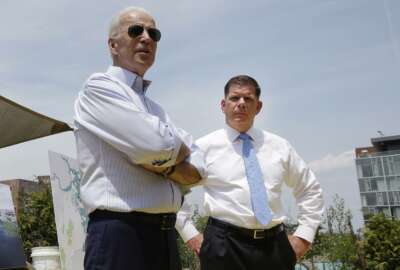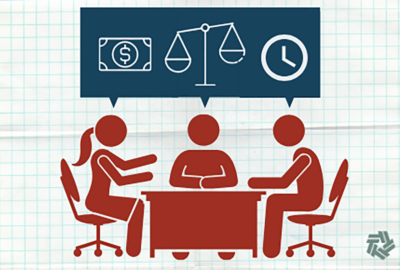
White House touts ‘significant results’ of task force after 80,000 feds opt to join a union
Federal unions have seen a roughly 20% increase in bargaining unit membership governmentwide, with close to 80,000 feds joining a union between 2021 and 2022.
Within one year, tens of thousands of eligible federal employees chose to join a union.
Federal unions saw a roughly 20% increase in bargaining unit membership governmentwide, with close to 80,000 feds joining a union between September 2021 and September 2022, according to a March 17 update from the White House Task Force on Worker Organizing and Empowerment.
The Biden administration credited the “significant results” to the work of the task force, a group that President Joe Biden created through an April 2021 executive order seeking to strengthen collective bargaining rights for federal employees.
Following the initial executive order, the task force, led by Vice President Kamala Harris, laid out 70 recommendations to improve labor-management relations for the federal workforce. Similar to the first priority of the President’s Management Agenda (PMA), the task force said it aims to position the federal government as a model employer, including through worker empowerment.
“We’re going to look in the mirror, as the administration that is over this federal government, and look at the condition and the well-being of federal workers,” Harris said during a March 10 task force meeting. “We have been doing the work of informing the federal workforce, and by extension, their family members and the public in general, about the benefits of union membership.”
Biden approved all 70 of the task force’s recommendations in February 2022, and since then, the task force said agencies have made significant progress in implementing the changes, leading to the influx of union membership. At the time the task force published its initial recommendations, more than 300,000 federal employees eligible to join a union were not actually in one.
“The task force has spent almost two years working with agencies in the federal government,” said outgoing Department of Labor Secretary Marty Walsh, a leader on the task force, during the March 10 meeting. “This work is having an impact. Agencies are working on more than 100 initiatives right now to support worker organizing and collective bargaining in the private and federal sectors.”
Walsh added that empowering unions, for both the public and private sectors, can improve workforce recruitment and retention.
“Collective bargaining can be a tool to strengthen companies — I’ve seen it over and over again,” he said. “When the relationship is strong, it makes workers more productive, it makes workers more appreciative, it makes workers connected to your company as a family.”
The efforts from the Biden administration come in stark contrast to several executive orders from the Trump administration, which challenged federal unions’ ability to represent bargaining unit members, for example, by cutting the amount of official time — or the number of on-the-clock hours that employees can use toward union-related work.
Among the 70 recommendations, the task force said the Office of Personnel Management should work to remove unnecessary barriers in federal workplaces impeding unions’ ability to organize employees and increase membership.
Additionally, the task force said the General Services Administration should eliminate obstacles that union organizers may face when trying to talk with employees and contractors on federal property about the potential benefits of organizing.
Agencies have made progress toward certain areas of the recommendations, such as removing barriers to non-public sector workers who are exercising their rights on federal property and federally controlled spaces, the task force said. The Department of Homeland Security, for one, has been working to improve access for worker organizing at airports.
The National Labor Relations Board, the Federal Labor Relations Authority and the Federal Mediation and Conciliation Service have also improved their collaboration when helping parties establish initial collective bargaining agreements, the task force said.
“These actions will make it possible for more workers to talk with and hear from union organizers at their workplaces — a significant step in addressing the imbalance of information that exists under current law,” the task force said.
OPM has issued multiple rounds of guidance to agencies on how to follow through on the task force recommendations. OPM’s guidance calls on agencies, for example, to let unions put materials on public-facing websites and bulletins, and to streamline the payroll deductions process for union dues.
More details from OPM outlined how agencies can ensure accuracy of which employees are excluded from union eligibility, and urged positive collaboration between labor and management. OPM also issued a survey to gather data on union membership of federal employees, which ultimately showed the 20% growth.
The task force recommendations overall focus on ensuring front line federal employees know their workplace rights, and that federal unions have information and access to best represent employees.
The National Treasury Employees Union, for one, is experiencing firsthand significant growth in membership. The federal union added more than 8,300 new members in fiscal 2021, compared with over 12,800 new members in fiscal 2022.
“Since President Biden approved the task force’s recommendations in February 2022, more federal employees are recognizing the benefits of union representation and are choosing to join NTEU,” National President Tony Reardon said in a statement. “And more federal agencies are working with NTEU in collaboration to improve their workplaces, all of which contributes to the federal government’s ability to carry out agency missions and better serve the American taxpayers.”
But the Biden administration said despite the progress toward implementing the recommendations, more plans are still ahead for the task force.
“The task force will continue to work with agencies to implement the recommendations and to look for opportunities to expand the reach of their work through collaboration with other agencies,” the White House said. “The task force will also continue its role as a forum to hear from workers, organizers, employers and other economic stakeholders about ways to reduce the barriers to collective bargaining and worker empowerment.”
Copyright © 2025 Federal News Network. All rights reserved. This website is not intended for users located within the European Economic Area.
Drew Friedman is a workforce, pay and benefits reporter for Federal News Network.
Follow @dfriedmanWFED




